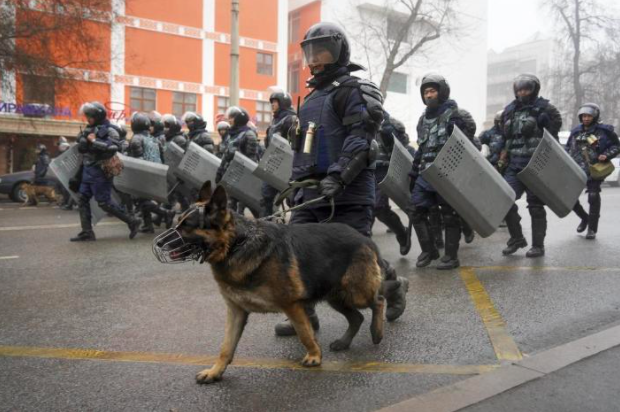By Ayeshah Shaikh
On January 2nd, protests in western Kazakhstan began spreading across the country as a result of the government cutting down on fossil fuel subsidies. This cut led to a steep and sudden increase in the price of liquefied petroleum gas (LPG), which most Central Asian people depend on to run their vehicles. This was a slap to the oil workers, especially those in western Kazakhstan, as it is the place where a majority of Kazakhstan’s oil production is located, and where 70 to 90 percent of the vehicles owned use this type of fuel. Despite contributing so much to the state budget and economy of Kazakhstan, the western region has been continuously neglected by the central government, fostering their hatred towards them even more. With the cities already running rampant with high rates of poverty and employment, as well the constant second-class treatment, the spike in prices was only the cherry on top for the protests to initiate.
However, what were once peaceful protests turned bloody after the police cracked down on the protesters, causing more than 220 deaths, nearly 8,000 arrests, and an accumulation of almost $3 billion for reparation of public buildings. On January 4th, Kazakhstan’s President Tokayev issued a statement promising to address the public’s demands and stated that the government is responsible for the current state of turmoil and unrest, while also warning the younger generation not to destroy their future.
However, Tokayev only angered the public even more with his statement, especially since the unrest followed the recent ten year anniversary of the government’s devastating quashing of the striking oil workers in Zhanaozen, where the protests first started. Citizens felt Tokayev had no idea what they faced everyday, especially as the standard of living had been swiftly deteriorating with a significant portion of the population living in poverty, even though the GDP per capita was $9,000. This led to a shift in focus from socioeconomic grievances to political demands as the protesters demanded the resignation of the president, freedom of political association, and direct election of regional governors. As victims of the violence also started to emerge, the authorities responded by shutting down the internet, only to have it backfire as more people took to the streets to figure out what was going on.
As the situation worsened in the country, it became apparent that the government was losing control and was struggling to come up with effective plans to resolve the many issues. A major reason was the fact that Tokayev was essentially a puppet of his successor, Nazarbayev. Despite stepping down after ruling for decades, Nazarbayev operated through the shadows by taking the position of the head of the country’s security council. The irony of these events was the fact that Nazarbayev was nowhere to be seen in the first few days of the uprising, as he was too busy tending to his needs in the Chinese resort of Hainan, leading Tokayev to take matters into his own hands. He fired the government, as well as the head of the secret service, Karim Massimov, a Nazarbayev loyalist, and took over the powers of the security of the council. This signaled that Tokayev was attempting to remove the second center of power and trying to take control of the country.
This overthrowing of power did not occur as smoothly as Tokayev would have wanted, with the first series of counterattacks starting during the day of January 5, when Nazarbayev’s clan swiftly mobilized and sent troops to take over of the KNB building, the presidential palace, and the airport in Almaty. However, despite it being an unfortunate turn of events, it gave Tokayev the opportunity to present it as a foreign interference and aggression, and be able to request aid from the Collective Security Treaty Organization (CSTO) as a result of it.
Overnight troops from Russia were flown in, as well as small contingents from Armenia, Tajikistan, Kyrgyzstan, and Belarus in Kazakhstan to help put an end to the counter-coup. They were effectively able to restore order in the city by arresting protesters or killing them and taking back control of Almaty’s airport. Tokayev was no longer bound by the restraints that prevented him from pursuing political or economic reform. What was once a cry against the unfair rise of prices in oil turned out to be a strategic plan to overthrow the puppeteers controlling the strings of Tokayev and the government of Kazakhstan. In the end, it only cost a “few” people’s lives, thousands arrested, and the ruin of many families.

